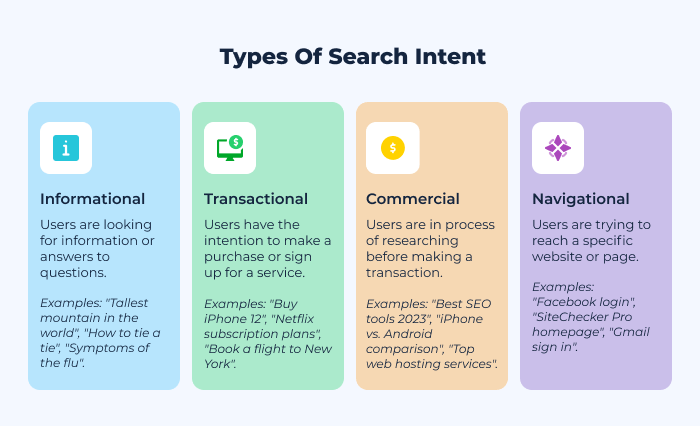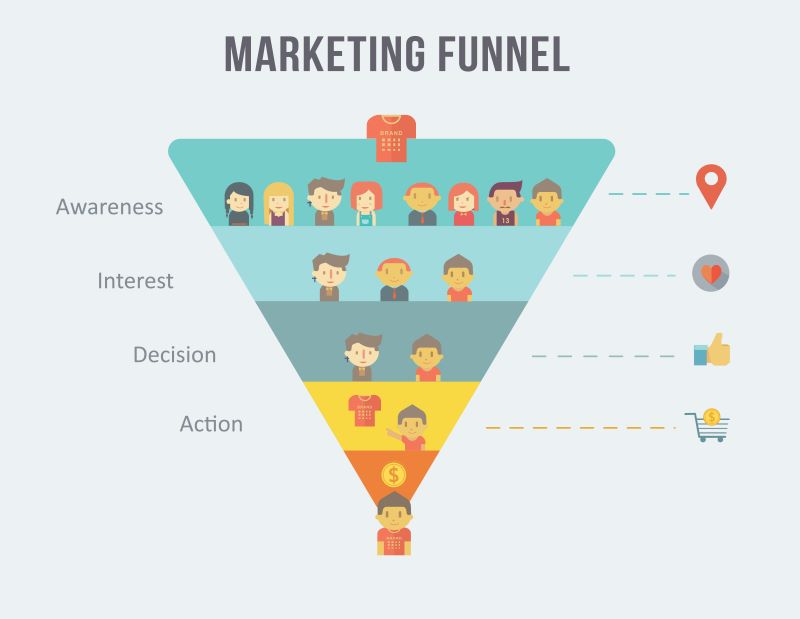Uncover the secret to unlocking user queries with search intent – learn how to increase engagement and drive traffic.

Image courtesy of via DALL-E 3
Table of Contents
Have you ever wondered why when you type something in a search engine, you get specific results? That’s because of something called search intent. Understanding search intent and targeting user queries is like being a detective trying to solve a mystery to help you find exactly what you’re looking for online. Let’s dive into the fascinating world of search intent and user queries to unravel this digital puzzle.
Imagine you’re looking for the best chocolate chip cookie recipe online. You type it into the search bar, and voila! A list of mouth-watering recipes appears. How did the search engine know what you wanted? It’s all about search intent and understanding what users like you are searching for. Let’s explore this concept a little further.
What is Search Intent?
Search intent, also known as user intent, refers to the reason behind a user’s search query on a search engine. It’s essential to understand what users are seeking when they type in a specific keyword or phrase. By understanding search intent, websites can create content that matches what users are looking for, thus improving their chances of appearing in search results.
Different Types of Search Intent
There are several types of search intent:
- Informational Intent: When a user is looking for information or answers to a question.
- Navigational Intent: When a user is searching for a specific website or webpage.
- Transactional Intent: When a user intends to make a purchase or engage in a transaction.
- Commercial Investigation Intent: When a user is researching a product or service before making a decision.
Understanding these different types of search intent can help website owners tailor their content to meet the needs of users.
Why is Search Intent Important?
Understanding search intent is crucial for creating content that is relevant to what users are searching for. Imagine you are looking for a recipe to make your favorite chocolate chip cookies. If you type “chocolate chip cookies recipe” into a search engine, you expect to find recipes, not information about the history of chocolate. This is where search intent comes into play.
Improving User Experience
When content aligns with search intent, users are more likely to find what they are looking for quickly and easily. This improves their overall experience by saving them time and frustration. For example, if you are searching for the best places to visit in New York City, you want a list of popular attractions, not a blog post about the writer’s personal trip to the city. Understanding search intent helps website owners tailor their content to meet user needs more effectively.
How Search Engines Understand Search Intent
Search engines like Google have complex algorithms that work behind the scenes to understand what users are looking for when they type a query into the search bar. These algorithms are designed to analyze various factors to determine search intent and provide users with the most relevant results.

Image courtesy of via Google Images
Using Keywords
One crucial way search engines understand search intent is by analyzing the keywords within a user’s query. Keywords act as clues that help search engines identify the purpose behind the search. For example, if someone types in “best pizza near me,” the search engine recognizes the keywords “best,” “pizza,” and “near me” to understand that the user is looking for nearby pizza places that are highly rated.
How to Identify Search Intent
Identifying search intent is crucial to creating content that resonates with users and ranks well in search engine results. By understanding what users are looking for when they type a query, you can tailor your content to meet their needs effectively. Here are some strategies to help you identify search intent:
Analyzing Keywords
One way to identify search intent is by analyzing the keywords within a query. Keywords give valuable clues about what the user is searching for and can help you determine the intent behind the search. For example, if a user types in “best hiking boots,” the intent is likely transactional, indicating that they are interested in purchasing hiking boots.
Using Tools
Tools like Google Analytics can also assist in identifying search intent. By analyzing user behavior on your website, you can gain insights into what users are searching for and tailor your content accordingly. These tools provide valuable data that can help you understand user intent and optimize your content strategy.
By utilizing both keyword analysis and tools like Google Analytics, you can effectively identify search intent and create content that meets the needs of your target audience.
Creating Content Aligned with Search Intent
When it comes to creating content for your website or blog, it’s crucial to ensure that it aligns with what users are searching for – their search intent. By understanding and catering to the needs of your audience, you can create content that not only ranks well in search results but also provides value to your users. Here are some tips on how to create content aligned with search intent:

Image courtesy of via Google Images
Match Content Type
One of the key aspects of aligning your content with search intent is to match the type of content to the user’s search query. For example, if a user is looking for a step-by-step tutorial on how to bake a cake, a video tutorial might be more helpful than a written blog post. By understanding the intent behind the search query, you can create content in the format that best serves the user’s needs.
Address User Questions
Another important aspect of creating content aligned with search intent is to directly address the questions and needs of your users. By structuring your content in a way that answers commonly asked questions or fulfills specific needs, you can ensure that your content is relevant and valuable to the user. This not only helps in providing a better user experience but also increases the chances of your content ranking higher in search results.
Evaluating Your Content
Once you’ve created your content to align with search intent, it’s essential to evaluate its effectiveness in engaging users and meeting their needs. By assessing how well your content performs, you can make necessary adjustments to ensure it remains relevant and valuable.
User Feedback
One valuable method to evaluate your content is by listening to user feedback. User comments, reviews, and direct messages can provide insights into whether your content is resonating with the intended audience. Pay attention to what users are saying about your content and use their feedback to make improvements.
Analytics Tools
Analytics tools play a crucial role in evaluating the performance of your content. Tools like Google Analytics can provide data on how users interact with your content, from page views and bounce rates to time spent on page and conversion rates. By analyzing this data, you can identify patterns, understand user behavior, and make informed decisions to optimize your content for better results.
Adapting to Changing Search Intent
As the internet evolves, so do the ways in which people search for information. It’s crucial for content creators to adapt to these changes in user behavior to ensure that their content remains relevant and helpful. Let’s explore the importance of adapting to changing search intent.

Image courtesy of via Google Images
Staying Updated
One of the key elements in adapting to changing search intent is staying updated on the latest trends and updates in user behavior. By keeping an eye on how users are searching and what they are looking for, content creators can tailor their content to meet these evolving needs.
For example, if a new trend emerges where users are searching for more visual content rather than text-based information, content creators can adapt by incorporating more images, infographics, or videos into their content.
By staying informed and agile in response to changing search intent, content creators can continue to provide value to their audience and maintain high levels of relevance in search results.
Conclusion
Understanding search intent and targeting user queries is essential for creating content that resonates with your audience. By aligning your content with what users are searching for, you can improve user experience, increase relevance in search results, and drive more traffic to your website.
Throughout this blog post, we’ve delved into the different types of search intent, why it’s important, how search engines interpret user queries, strategies for identifying search intent, creating content that matches user needs, evaluating content effectiveness, and adapting to changing search patterns. Each of these aspects plays a crucial role in optimizing your content for better visibility and engagement.
Remember, analyzing keywords, using tools like Google Analytics, and staying updated with user behavior trends are key practices in honing your understanding of search intent. By consistently refining your content based on evolving user needs, you can stay ahead in the digital marketing landscape.
So, as you delve into the world of search intent and user queries, keep in mind the importance of meeting user needs, addressing their questions directly, and adapting your content strategy to align with changing search patterns. By doing so, you’ll be well-equipped to create content that not only ranks well in search results but also resonates with your target audience.
Want to turn these SEO insights into real results? Seorocket is an all-in-one AI SEO solution that uses the power of AI to analyze your competition and craft high-ranking content.
Seorocket offers a suite of powerful tools, including a Keyword Researcher to find the most profitable keywords, an AI Writer to generate unique and Google-friendly content, and an Automatic Publisher to schedule and publish your content directly to your website. Plus, you’ll get real-time performance tracking so you can see exactly what’s working and make adjustments as needed.
Stop just reading about SEO – take action with Seorocket and skyrocket your search rankings today. Sign up for a free trial and see the difference Seorocket can make for your website!
Frequently Asked Questions (FAQs)
What is the quickest way to identify search intent?
The quickest way to identify search intent is by analyzing the keywords within the user query. By looking at the specific terms used in the search, you can get a good idea of what the user is looking for. For example, if someone searches for “best chocolate cake recipe,” the intent is likely informational, indicating the user is looking for a recipe rather than a product or a specific website.
How often should I update my content based on search intent?
It’s important to regularly update your content to align with changing search intent. Depending on your industry and the frequency of shifts in user behavior, updating content every few months may be necessary. By keeping an eye on trends and monitoring changes in search patterns, you can ensure that your content remains relevant and continues to meet the needs of users.







